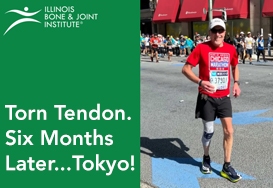The ACL – what is it and how is it repaired?
Below, you will find a comprehensive guide detailing the specifics of ACL tears – how to identify a potential ACL injury, proper treatment, and recommended rehabilitation of the overall knee joint.
What Does the ACL Do?
The ACL, or Anterior Cruciate Ligament, is vital to knee stabilization. This strong band of tissue located in the center of the knee and it connects the femur to the tibia, and is responsible for helping you run, jump, walk and play. A ligament tear can significantly impact your everyday life, so if there is suspicion of a tear, you should seek medical attention as soon as possible so that a physician can evaluate the severity of the injury and create a plan of care should a repair be necessary.
How Does an ACL Tear?
An ACL tear is usually associated with a twisting motion of the knee which commonly occurs playing sports, however the injury is not exclusive to athletes. In fact, an ACL tear can result from blunt trauma to the knee, a trip or fall, or any unnatural motion of the knee joint, including hyperextension.
ACL Tear Symptoms
Early recognition of the symptoms of an ACL tear is important. The most common symptom is an audible “pop” when it occurs, followed by pain, swelling and tenderness to the entire knee area. Another symptom of an ACL tear is the feeling of instability in the joint – meaning it becomes increasingly difficult to walk or put weight on the affected leg. A reduced range of motion is also common, so there is difficulty in rotating and bending the knee. If you have any symptoms of an ACL tear, a medical professional should immediately address it.
ACL Surgery
When is ACL Reconstruction Surgery Necessary?
After a ligament tear, ACL reconstruction surgery may be necessary. In cases where the tear is very minor, surgery may not be required. In these few instances, it is possible for the joint to heal on its own; however, a patient will still require the use of a knee brace and physical therapy to ensure proper healing. Unfortunately, most people suffering from an ACL tear will require a surgical procedure called ACL Reconstruction. This surgery involves an orthopedic surgeon using tendon grafts cultivated from another area of the patient’s body (or from a cadaver), to reconstruct the torn ACL ligament.
Preparing for ACL Reconstruction
Some orthopedists may recommend physical therapy prior to scheduling surgery. The goal of this physical therapy (“prehab”) is to reduce swelling and minimize joint pain before the surgical procedure. This will help ensure a more favorable surgical outcome by building and maintaining muscle strength – no matter how limited – to make rehab easier.
The ACL Reconstruction Surgical Procedure
ACL reconstruction is best performed by an experienced orthopedic surgeon. The surgeon makes a small incision on the front of your knee and removes a band of tendon tissue from the kneecap area. This tissue is then used to replace the damaged ACL once it is removed.
ACL Rehabilitation
Rehabilitation is just as vital to the full recovery of the ACL tear as the reconstructive procedure itself. During this time the body will begin to heal, build strength, and prepare to function at full capacity. It is important to work closely with your orthopedic surgeon and physical therapist in order to fully, safely and efficiently recover from an ACL tear.
How Long is ACL Reconstruction Rehabilitation?
ACL reconstruction rehabilitation is a process that will last around nine months. While this may seem like a long time, this process is broken up into phases to ensure proper healing and strength building. While your surgeon may have a unique rehab protocol, most mimic the following order.
- Phase 1: This takes place during the first 2 weeks following surgery when the patient must rest with minimal mobility.
- Phase 2: During the 2-6 weeks following surgery, mobility begins to restore and early strengthening exercises begin.
- Phase 3: This phase occurs during the 6 weeks to 4 months following surgery when functional strengthening is developed. During this time physical therapy and strength training under the guidance of a physical therapist is imperative to ensure a full recovery.
- Phase 4: Lastly, during the 4 to 9 months following ACL surgery, the patient can slowly return to normal activities.
Everyone’s healing and rehabilitation from an ACL tear will be different, and it is important not to rush the healing process in order to avoid further damaging the knee.
Get the Help You Need for an ACL Tear
The orthopedic surgeons at Illinois Bone & Joint Institute specialize in ACL reconstruction and will work closely with you, tailoring a protocol that will quickly and safely return you to the life that you enjoy. Schedule online at IBJI today.
*This content is for information only and is not intended to replace the diagnosis, treatment, or medical advice from your treating healthcare professionals. The content does not provide medical advice, does not constitute the practice of medicine or other healthcare professional services, and does not create a doctor-patient relationship. You should not rely on this information as a substitute, nor does it replace professional medical advice, diagnosis, or treatment. If you have concerns or questions, seek the advice of your healthcare professionals. If you think you may have a medical emergency, call your doctor or 911 immediately. Do not rely on electronic communications or communicate through this website for immediate, urgent medical needs. This website is not designed to facilitate medical emergencies. The use of the information is at the reader’s own risk. The links are provided for information and convenience only. We cannot accept responsibility for the sites linked or the information found here. A link does not imply an endorsement of a site.




